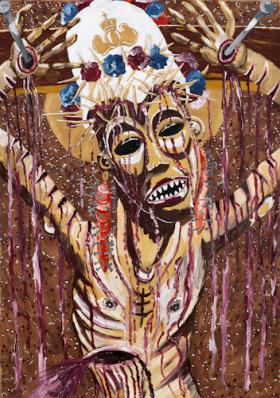Andrew Gilbert, Les maîtres fous, starring Andrew and Emil Nolde
Opening Thursday April 25 starting 6 pm
As the Drums beat, they painted Flowers
As Natives heads were hacked, they sketched Masks Shocking and Savage
Erotic and Wild
On the First day God created Europe, and then he created Darkness...
Andrew Gilbert
Queen Victoria, Shaka Zulu as a dictator-messiah, Jesus, Macbeth, the Mad Mullah of Somalia and Emil Nolde will join us for Andrew Gilbert’s next exhibition at the gallery. In his drawings, he re-enacts Europe’s colonial history and its profligate aggression against local populations. Starting from accurate facts, he stages himself in a kind of History that can take imaginative, jocular and anachronistic detours.
This exhibition takes place under the sign of The Mad Masters (1955), a documentary by Jean Rouch which Andrew Gilbert watched while working on this new series of artworks. The film unveils a rite of religious possession practiced by a sect of the Niger, whose members wear colonial helmets and carry wooden rifles to incarnate, in the course of a violent simulacrum, various figures of the dominant British hierarchy. This process of catharsis through disguise joins the farcical role-play of the artist, who adopts the appearance of a European Queen, a Zulu chief or an army soldier.
This time, Andrew Gilbert returns from Africa where, with his fellow traveller Emil Nolde, he witnessed the acts of extreme brutality and savagery perpetrated by the British and German European powers. Here they are, dressed as birds in military uniforms, as they paint or drink tea in the middle of scenes of massacre. In European Flowers, a flower arrangement in a vase evokes the European idea of civilised and controlled nature, but a blood-drenched face, pierced with nails, makes it tip over to the side of barbarism. Andrew and Nolde are still there, in miniature; they are painting the flowers, but all they see in them are violent African masks. Diametrically opposed to any form of Edenic exoticism, they are far from the journey across the Pacific made by the German painter on the trail of Paul Gauguin.
Created with a mixture of acrylics, ink and pencil, Andrew Gilbert’s drawings have an unquestionable suggestive power. His manner has evolved towards an increasingly corporeal treatment, moving from pencil to acrylic, from lines to colour. The sheet, slashed with a cutter in the manner of scarification, is covered with sentences that look like incantations. African art is a source of formal inspiration passing through the prism of German expressionism; Emil Nolde is one of its figures. In Trophies of the Savages, Gilbert revisits Nolde’s famous 1911 painting Still Life with Masks. The masks become severed heads, reminding the viewer of the decapitations of the Herero and Namaqua people, perpetrated by the Germans in Namibia (1904-1911). Gilbert’s paintings are also heavily imbued with cinematic and literary representations of colonial history, which he integrates in his work by re-interpreting cinema and cabaret posters.
Born in Edinburgh in 1980, Andrew Gilbert attended the Edinburgh Fine Art University of Edinburgh and Edinburgh College of Art from 1997 to 2002. He had numerous personal exhibitions throughout Europe, in particular in Prague, Hamburg, Berlin, Amsterdam and Paris. He live and works in Prague since 2002.
